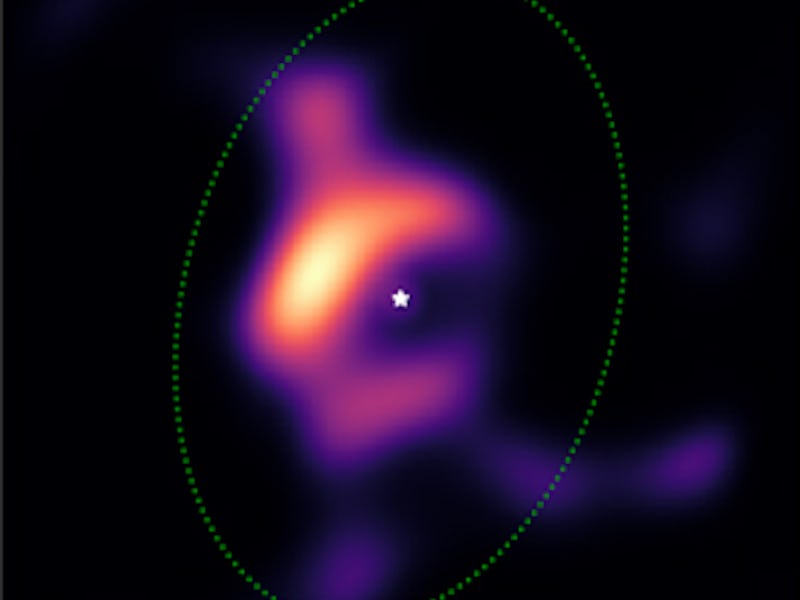New images reveal what planets are made of in stunning fluorescent detail
These planetary-forming disks are in unison with their stars.

In the vast cosmos, particles of gas and dust swirl into a disk-shaped cloud, colliding together as they orbit the host star and eventually resulting in the birth of a planet.
Scientists have been observing this birthing process for years in an effort to understand how worlds like our own came to be in the first place. Now, new images reveal this very origin of planet formation in unprecedented detail.
A team of astronomers captured fifteen images of the inner rims of the disks from which planets form, revealing new details about the planetary-formation process.
The results were published Thursday in the journal Astronomy & Astrophysics.
These 15 images reveal the process by which planets form in great detail.
The new images show the planetary-forming disks, with the inner rims appearing like fluorescent lava lamps floating in space. The disks form in unison with their host stars, and the grains of dust in the disks can keep colliding with one another until they form a larger body, a planet.
Prior to these images, astronomers had gotten a glimpse at these disks but never in such detail. However, the team of scientists behind the new study used the European Southern Observatory (ESO) in Chile to look at the protoplanetary disks located hundreds of light years away from Earth. They combined the light collected by four telescopes at the Very Large Telescope observatory with a technique called infrared interferometry.
After gathering the initial observations, the team was able to reveal even more details in the images with a mathematical reconstruction technique, similar to the one used to capture the first image of the black hole in 2019, where they remove the interference coming from the light of the star.
"Infrared interferometry is becoming routinely used to uncover the tiniest details of astronomical objects," Jean-Philippe Berger an astronomer at the Université Grenoble-Alpes, and lead author of the new study, says in a statement. "Combining this technique with advanced mathematics finally allows us to turn the results of these observations into images."
These disks can lead to the birth of a planet like the Earth.
The amount of detail is equivalent to being able to see a human on the Moon, or distinguish a hair at a 10 kilometer distance, according to Berger.
And all that detail paid off, with the images revealing some clues about the process by which planets form.
The team of researchers identified some irregularities in the images between one protoplanetary disk and another. "You can see that some spots are brighter or less bright, like in the images above: this hints at processes that can lead to planet formation," Berger said. "There could be instabilities in the disk that can lead to vortices where the disk accumulates grains of space dust that can grow and evolve into a planet."
Scientists believe that rocky planets like our own Earth form in the inner regions of protoplanetary disks, less than five astronomical units away from the star which they orbit.
The researchers are hoping to be able to observe this process in real time, with future observations that would witness the birth of planets in the area that is closer to the star.
Abstract: Context. The innermost astronomical unit (au) in protoplanetary disks is a key region for stellar and planet formation, as exoplanet searches have shown a large occurrence of close-in planets that are located within the first au around their host star.
Aims. We aim to reveal the morphology of the disk inner rim using near-infrared interferometric observations with milli-arcsecond resolution provided by near-infrared multitelescope interferometry. Methods. We provide model-independent reconstructed images of 15 objects selected from the Herbig AeBe survey carried out with PIONIER at the Very Large Telescope Interferometer (VLTI), using the semi-parametric approach for image reconstruction of chromatic objects (SPARCO). We propose a set of methods to reconstruct and analyze the images in a consistent way.
Results. We find that 40% of the systems (6/15) are centrosymmetric at the angular resolution of the observations. For the rest of the objects, we find evidence for asymmetric emission due to moderate-to-strong inclination of a disk-like structure for ∼30% of the objects (5/15) and noncentrosymmetric morphology due to a nonaxisymmetric and possibly variable environment (4/15, ∼27%). Among the systems with a disk-like structure, 20% (3/15) show a resolved dust-free cavity. Finally, we do not detect extended emission beyond the inner rim. Conclusions. The image reconstruction process is a powerful tool to reveal complex disk inner rim morphologies, which is complementary to the fit of geometrical models. At the angular resolution reached by near-infrared interferometric observations, most of the images are compatible with a centrally peaked emission (no cavity). For the most resolved targets, image reconstruction reveals morphologies that cannot be reproduced by generic parametric models (e.g., perturbed inner rims or complex brightness distributions). Moreover, the nonaxisymmetric disks show that the spatial resolution probed by optical interferometers makes the observations of the near-infrared emission (inside a few au) sensitive to temporal evolution with a time-scale down to a few weeks. The evidence of nonaxisymmetric emission that cannot be explained by simple inclination and radiative transfer effects requires alternative explanations, such as a warping of the inner disks. Interferometric observations can therefore be used to follow the evolution of the asymmetry of those disks at an au or sub-au scale.